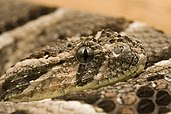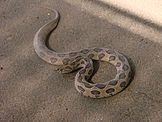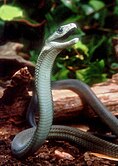Portal:Snakes/Snake articles
| This Wikipedia page has been superseded by Portal:Snakes and is retained primarily for historical reference. |
| Note: Article entries are now being transcluded directly on the main portal page. However, this page should be retained for historical reference. |
Snake articles 1
Portal:Snakes/Snake articles/1
Forty-seven species of snake have been recorded in Trinidad and Tobago, making the snake population of this area the most diverse in the Caribbean. Forty-four of these snake species are found in Trinidad and twenty-one in Tobago. Many of these species are South American, most of which are present in Venezuela. Trinidad and Tobago consists of two main islands, Trinidad and Tobago, and several smaller islands. The Bocas Islands, which lie between Trinidad and Venezuela, in the Bocas del Dragón (Dragon's Mouths), consist of Chacachacare, Monos, Huevos and Gaspar Grande. Several smaller islands lie off Trinidad, but snakes have been recorded on only one of them, Caledonia Island. Snakes have been recorded on one island off Tobago, Little Tobago. Four species are venomous: two coral snake species (Micrurus spp.), the fer-de-lance (Bothrops atrox) and the South American bushmaster (Lachesis muta). The common coral (Micrurus fulvius) is found on at least two of the Bocas Islands: Gaspar Grande and Monos. No venomous snakes inhabit Tobago.(see more...)Snake articles 2
Portal:Snakes/Snake articles/2
The puff adder (Bitis arietans) is a highly venomous viper species found in savannahs and grasslands from Morocco and western Arabia throughout Africa except for the Sahara and rainforest regions. It is responsible for causing the most snakebite fatalities in Africa owing to various factors, such as its wide distribution, frequent occurrence in highly populated regions, and aggressive disposition. Like all other vipers, it is venomous. Two subspecies are currently recognized, including the nominate subspecies described here.The species is commonly known as the puff adder, African puff adder, or common puff adder. (Full article...) (Full article...)
Snake articles 3
Portal:Snakes/Snake articles/3
The Russell's viper is a monotypic genus of venomous Old World viper. The single species, D. russelii, is found in Asia throughout the Indian subcontinent, much of Southeast Asia, southern China and Taiwan. The species was named in honor of Patrick Russell (1726–1805), a Scottish herpetologist who first described many of India's snakes; and the name of the genus is from the Hindi word meaning "that lies hid", or "the lurker." Apart from being a member of the big four snakes in India, Daboia is also one of the species responsible for causing the most snakebite incidents and deaths among all venomous snakes on account of many factors, such as their wide distribution and frequent occurrence in highly populated areas. Two subspecies are currently recognized, including the nominate subspecies described here. (Full article...)Snake articles 4
Portal:Snakes/Snake articles/4
The black mamba (Dendroaspis polylepis) is a species of highly venomous snake belonging to the family Elapidae. It is native to parts of sub-Saharan Africa. First formally described by Albert Günther in 1864, it is the second-longest venomous snake after the king cobra; mature specimens generally exceed 2 m (6 ft 7 in) and commonly grow to 3 m (9.8 ft). Specimens of 4.3 to 4.5 m (14 to 15 ft) have been reported. Its skin colour varies from grey to dark brown. Juvenile black mambas tend to be paler than adults and darken with age. Despite the common name, the skin of a black mamba is not black; the color name describes rather the inside of its mouth, which it displays when feeling threatened.The species is both terrestrial (ground-living) and arboreal (tree-living); it inhabits savannah, woodland, rocky slopes and in some regions, dense forest. It is diurnal and is known to prey on birds and small mammals. Over suitable surfaces, it can move at speeds up to 16 km/h (10 mph) for short distances. Adult black mambas have few natural predators.
In a threat display, the black mamba usually opens its inky-black mouth, spreads its narrow neck-flap and sometimes hisses. It is capable of striking at considerable range and may deliver a series of bites in rapid succession. Its venom is primarily composed of neurotoxins that often induce symptoms within ten minutes, and is frequently fatal unless antivenom is administered. Despite its reputation as a formidable and highly aggressive species, the black mamba attacks humans only if it is threatened or cornered. It is rated as least concern on the International Union for Conservation of Nature (IUCN)'s Red List of Threatened Species. (Full article...) (Full article...)



